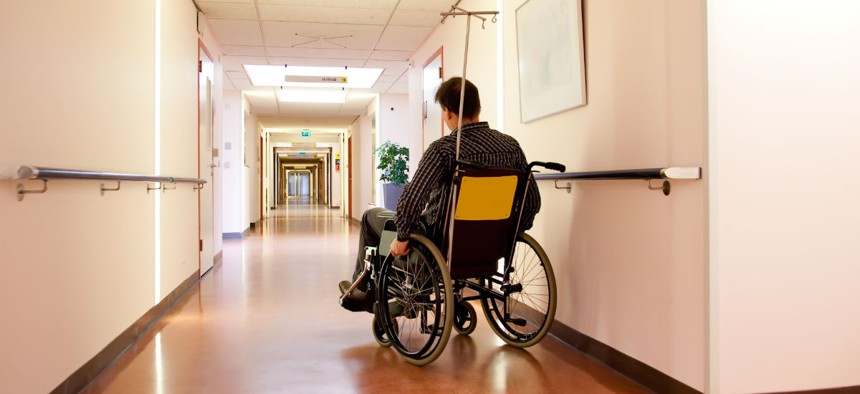
Surprise Inspections Show VA Health Care Improvement Since Phoenix Scandal
But the agency’s continuing struggle to hire and keep staff hurts vets’ access to care, says the Joint Commission.
The Veterans Health Administration has improved the quality of and access to health care for vets over the past two years, but the agency’s continuing struggle with hiring and retaining employees is undermining its mission, according to a newly-released report from an outside organization.
“Staffing shortages significantly impacted the organization’s ability to meet veterans’ needs and led to delays in care,” said a Joint Commission survey of 139 VHA facilities and 47 community-based outpatient clinics between October 2014 and September 2015. The Joint Commission, which is a widely-respected independent non-profit that accredits and certifies nearly 21,000 health care organizations and programs in the country, began conducting surprise surveys of the facilities soon after the 2014 scandal erupted in Phoenix involving patient wait times and access to care. The Veterans Affairs Department asked the Joint Commission to do the review, and provided performance data and other information as benchmarks so surveyors could target VHA’s biggest weaknesses and properly assess the validity of the agency’s statistics. Individual facilities, however, did not know when the Joint Commission planned to pop in for a review.
“We commend VA for being proactive by requesting the Joint Commission to conduct unannounced site visits at all their medical centers to review and evaluate their efforts to improve access and quality of care,” said Dr. Mark Chassin, president and CEO of the Joint Commission. “VA was the first system ever to request an assessment with an important focus on access so that deficiencies could be identified and rapidly addressed.” Chassin added that his organization was “pleased with VA’s ongoing commitment to quality improvement and patient safety.”
The Joint Commission looked at several areas related to VHA management: processes related to timely access to and coordination of health care for veterans; VHA leadership; the culture of safety at the facilities; staffing levels and competency; and infection prevention and control at hospitals and clinics. The organization found a total of 225 “requirements for improvement” in its review of the VHA system as a whole, most of which the VA had corrected as of April 2016 as part of the Joint Commission’s follow-up review.
The most infractions were found in the area of infection prevention and control, specifically the processes related to the cleaning and sterilization of instruments, which the Joint Commission said could be addressed though better staff training. After the follow-up, however, the commission found this area remained “problematic.”
The leadership category, which included staffing challenges, had the second highest-number of RFIs in the focus survey, although VHA showed improvement in this area in the commission’s follow-up review. Nevertheless, recruitment and retention of employees is still a problem for the VHA, and staffing shortages have an effect on access to care, particularly when it comes to scheduling patient appointments, the report said. “But as new staff were hired, the waiting times for appointments were being more effectively addressed,” the commission said.
The VHA had trouble hiring staff quickly, and geography played a role in hampering the agency’s efforts, according to the report. “For example, rural and remote communities had, in general, more difficulty in recruiting and retaining key staff,” the report said. “VHA organizations located in major metropolitan areas had a different challenge, often competing for quality staff with a number of local area hospitals.” Also, different guidance and practices at VHA facilities involving discharging patients and scheduling follow-up appointments often caused confusion. However, issues related to scheduling delays was “most often due to specialty provider shortages, rather than through issues with the scheduling process itself,” the report said.
Dr. David Shulkin, VA’s undersecretary of health, also has blamed the department’s recruitment struggles on its negative image in the media and elsewhere. “Our applications for clinical positions across the board are down 78 percent,” since the patient wait times scandal erupted two years ago, he said in July.
The Joint Commission interviewed and tracked the health care experience of more than 2,000 patients for its review, and found that vets liked their VA health care, despite VHA’s widespread problems. “Although implementation of the [2014] Choice Act occurred in the latter phase of the project, early discussions with veterans indicated a strong preference, and even a loyalty, for their ‘own’ VHA organization, even if it would mean waiting longer to be seen,” the report said. The Choice Act gave certain vets expanded access to health care outside of the VA system if they encountered problems with access.
But delays related to scheduling appointments isn’t specific to the VA, the commission noted.
“VHA organizations and veterans also report that many times, appointments in the community could not be made any earlier than would’ve been possible at the VHA, particularly as they worked to achieve more success in addressing their own wait times.”
The Joint Commission said that all VHA facilities should continue to monitor the timeframe for scheduling patient appointments, assess challenges with implementing the Choice Act, and develop a process for tracking referrals outside the VHA network, among several other recommendations.







